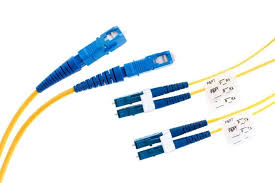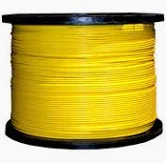Fiber optic technology has revolutionized internet access, data sharing, and communication. Fiber optics provide lightning-fast speeds and dependable connections whether they are utilized in a data center, a telecommunications network, or a home internet connection. However, not every fiber optic cable is made equally. One of the most important choices you will have to make when selecting fiber for your network is whether to use single mode or multimode fiber.
Each type has its own advantages, disadvantages, and best applications. The main distinctions between single mode and multimode fiber, their functions, and when to use each type will all be covered in this blog. No engineering degree is necessary, and we’ll use clear, simple language.

What Is Fiber Optic Cable?
Before we dive into the differences, let’s quickly go over what fiber optic cables are and how they work.
Let’s quickly review the definition and operation of fiber optic cables before delving into the differences.
Fiber optic cables, which are intended to transmit data in the form of light, are composed of incredibly thin glass or plastic strands. Fiber cables use light to transmit data over great distances at extremely high speeds, in contrast to conventional copper cables, which use electrical signals.
Each fiber strand has three main parts:
- Core: The center of the fiber where light travels.
- Cladding: A layer that reflects light back into the core.
- Coating: Protective outer layers that shield the fiber from damage.
The size of the core and how light travels through it are what set single mode and multimode fiber apart.
What Is Single Mode Fiber?
The core of a single mode fiber is extremely thin, usually measuring 8 to 10 microns in diameter. Only one mode of light can pass directly down the fiber due to the core’s extreme narrowness. Consider it to be as direct and focused as a laser pointer.
Because of this design, there is less chance of light bouncing around inside the core, allowing the signal to travel much farther without deteriorating.
Key Characteristics of Single Mode Fiber:
- Core Size: ~9 microns
- Light Source: Laser
- Distance: Up to 100 km or more (with proper equipment)
- Bandwidth: Extremely high
- Cost: More expensive than multimode for both cables and transceivers
- Color Code (Jackets): Yellow
What Is Multimode Fiber?
The core of multimode fiber is typically larger, ranging from 50 to 62.5 microns. Multiple modes of light can pass through the fiber simultaneously thanks to this larger core. Instead of using a laser, try shining a flashlight into a tunnel; light bounces around and travels in different directions.
Compared to single mode fiber, the signal’s reach is limited by modal dispersion, or signal spreading, which occurs when the signal spreads over longer distances due to these multiple light paths.
Key Characteristics of Multimode Fiber:
- Core Size: 50 or 62.5 microns
- Light Source: LED
- Distance: Up to 2 km (typically less)
- Bandwidth: Lower than single mode
- Cost: Cheaper cables and transceivers
- Color Code (Jackets): Orange or Aqua (depending on the type)
Key Differences Between Single Mode and Multimode Fiber
Let’s break it down side by side so you can clearly see the contrast:
| Feature | Single Mode Fiber | Multimode Fiber |
| Core Size | ~9 microns | 50 or 62.5 microns |
| Light Source | Laser | LED |
| Transmission Mode | One mode | Multiple modes |
| Distance | Up to 100+ km | Up to 2 km |
| Bandwidth | Higher | Lower |
| Cost | Higher | Lower |
| Jacket Color | Yellow | Orange or Aqua |
| Typical Use | Long-distance, telecom, data centers | Short-distance, LAN, office networks |
Use Cases: When to Use Single Mode Fiber
1. Telecommunications and Internet Backbone
Single mode fiber is used by telecom providers and ISPs to link cities, nations, and even continents. It is perfect for this because of its high bandwidth and long-distance capabilities.
2. Data Centers
In large-scale infrastructure or between data centers, where signals must travel great distances without losing their quality, single mode is frequently utilized.
3. Campus Networks
Single mode fiber can be used to connect internal networks at universities or corporate campuses with several buildings located far apart.
4. Long-Haul Networking
Single mode is used in any application that needs transmission over tens or hundreds of kilometers, such as submarine cables or metro fiber rings.
Pros:
- Best for long distances
- High bandwidth
- Future-proof
Cons:
- More expensive
- Requires laser-based transceivers
Use Cases: When to Use Multimode Fiber
1. Local Area Networks (LANs)
For networks within a single building or campus, multimode fiber is ideal, particularly when the distance is less than two kilometers.
2. Data Centers (Short Distance)
Multimode is frequently used in data centers for short-range connections between switches and servers, whereas single mode is utilized for longer links.
3. Security Systems
Multimode fiber is frequently used in buildings for CCTV and access control systems due to the short distances and lower cost.
4. Audio/Visual and Broadcasting
Multimode is a good fit for transmitting high-quality video signals in studios or live event setups.
Pros:
- Lower cost
- Easier to work with
- Cheaper electronics (LED-based)
Cons:
- Limited to short distances
- Lower bandwidth than single mode
OM Ratings in Multimode Fiber
When discussing multimode fiber, you may hear terms like OM1, OM2, OM3, OM4, or OM5. These denote various multimode fiber grades, each with a unique set of capabilities.
| OM Type | Core Size | Max Distance (10Gbps) | Jacket Color |
| OM1 | 62.5 µm | Up to 33 meters | Orange |
| OM2 | 50 µm | Up to 82 meters | Orange |
| OM3 | 50 µm | Up to 300 meters | Aqua |
| OM4 | 50 µm | Up to 400 meters | Aqua |
| OM5 | 50 µm | Up to 400 meters (with SWDM) | Lime Green |
If you’re planning for future upgrades, OM4 or OM5 is a safe bet for multimode environments.
Making the Right Choice
Choosing between single mode and multimode fiber depends on a few key factors:
1. Distance
If your network needs to span several kilometers or more, go with single mode. For shorter distances (less than 2 km), multimode should work fine.
2. Budget
In general, multimode fiber systems are less expensive, particularly in terms of transceivers. However, single mode might be worth the additional expense if you’re planning for the long term.
3. Bandwidth Requirements
Do you require the fastest speed and most bandwidth available? The best option is single mode. Multimode provides ample capacity for the majority of campus or business applications.
4. Environment
Think about the fiber’s installation location and method. While single mode fiber is better suited for lengthy outdoor runs, multimode fiber is simpler to terminate and install in confined indoor spaces.
Final Thoughts
High-speed communication will be facilitated by fiber optics in the future, and both single-mode and multimode fibers are essential. Whether you’re wiring a data center, a school, a smart building, or a large campus, knowing the differences will help you make better network setup decisions.
In short:
- Use single mode for long distances and high-bandwidth needs.
- Use multimode for shorter distances and cost-efficiency.
Still unsure? It never hurts to consult a network specialist or installer to review your unique needs and recommend the best type of fiber. You can also explore the bulk fiber optic cables at Firefold.
